videofluorographic observations on swallowing in patients with
advertisement
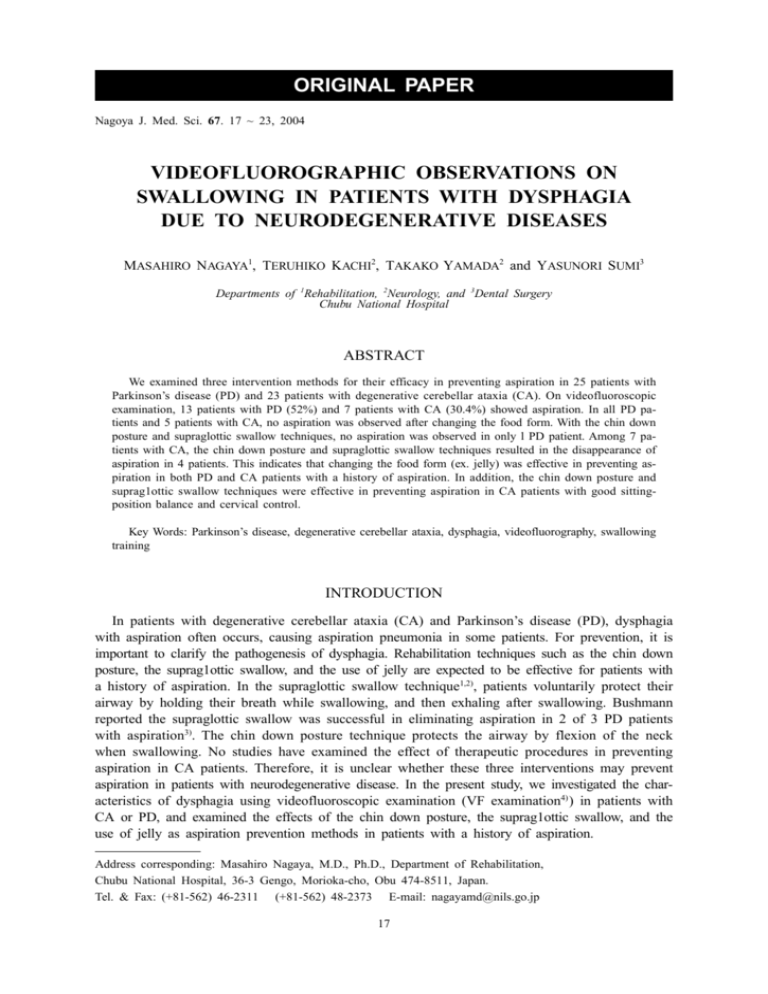
ORIGINAL PAPER Nagoya J. Med. Sci. 67. 17 ~ 23, 2004 VIDEOFLUOROGRAPHIC OBSERVATIONS ON SWALLOWING IN PATIENTS WITH DYSPHAGIA DUE TO NEURODEGENERATIVE DISEASES MASAHIRO NAGAYA1, TERUHIKO KACHI2, TAKAKO YAMADA2 and YASUNORI SUMI3 Departments of 1Rehabilitation, 2Neurology, and 3Dental Surgery Chubu National Hospital ABSTRACT We examined three intervention methods for their efficacy in preventing aspiration in 25 patients with Parkinson’s disease (PD) and 23 patients with degenerative cerebellar ataxia (CA). On videofluoroscopic examination, 13 patients with PD (52%) and 7 patients with CA (30.4%) showed aspiration. In all PD patients and 5 patients with CA, no aspiration was observed after changing the food form. With the chin down posture and supraglottic swallow techniques, no aspiration was observed in only l PD patient. Among 7 patients with CA, the chin down posture and supraglottic swallow techniques resulted in the disappearance of aspiration in 4 patients. This indicates that changing the food form (ex. jelly) was effective in preventing aspiration in both PD and CA patients with a history of aspiration. In addition, the chin down posture and suprag1ottic swallow techniques were effective in preventing aspiration in CA patients with good sittingposition balance and cervical control. Key Words: Parkinson’s disease, degenerative cerebellar ataxia, dysphagia, videofluorography, swallowing training INTRODUCTION In patients with degenerative cerebellar ataxia (CA) and Parkinson’s disease (PD), dysphagia with aspiration often occurs, causing aspiration pneumonia in some patients. For prevention, it is important to clarify the pathogenesis of dysphagia. Rehabilitation techniques such as the chin down posture, the suprag1ottic swallow, and the use of jelly are expected to be effective for patients with a history of aspiration. In the supraglottic swallow technique1,2), patients voluntarily protect their airway by holding their breath while swallowing, and then exhaling after swallowing. Bushmann reported the supraglottic swallow was successful in eliminating aspiration in 2 of 3 PD patients with aspiration3). The chin down posture technique protects the airway by flexion of the neck when swallowing. No studies have examined the effect of therapeutic procedures in preventing aspiration in CA patients. Therefore, it is unclear whether these three interventions may prevent aspiration in patients with neurodegenerative disease. In the present study, we investigated the characteristics of dysphagia using videofluoroscopic examination (VF examination4) ) in patients with CA or PD, and examined the effects of the chin down posture, the suprag1ottic swallow, and the use of jelly as aspiration prevention methods in patients with a history of aspiration. Address corresponding: Masahiro Nagaya, M.D., Ph.D., Department of Rehabilitation, Chubu National Hospital, 36-3 Gengo, Morioka-cho, Obu 474-8511, Japan. Tel. & Fax: (+81-562) 46-2311 (+81-562) 48-2373 E-mail: nagayamd@nils.go.jp 17 18 Masahiro Nagaya et al. SUBJECTS Twenty five patients (12 men, 13 women) with PD and 23 patients with CA (9 men, 14 women) who had dysphagia were studied. All subjects were referred to the department of rehabilitation for dysphagia evaluation. The PD patients ranged in age from 52 to 86 years (mean±SD: 70.2±9.1 years). Their illness duration ranged from 5 to 33 years (mean±SD: 10.4±7.0 years). According to the Hoehn and Yahr disability scale5), 12 patients were at stage 3; 4 were at stage 4; and 9 were at stage 5. Patients with severe dementia, depression, or other disorders interfering with swallowing or pulmonary function were excluded. All patients had the communicative and cognitive functions necessary to perform the chin down posture and supraglottic swallow techniques. The CA patients ranged in age from 29 to 69 years (mean±SD: 56.7±13.3 years). The disease duration ranged from 1 to 22 years (mean±SD: 6.7±4.7 years). The types of CA included 9 patients with multiple system atrophy (MSA), 3 patients with Machado-Joseph disease (MJD), 1 patients with sporadic spinocerebellar ataxia (SCA2), 2 patients with hereditary spinocerebellar ataxia (hereditary SCA) (not yet confirmed in molecular genetics), 5 patients with hereditary cortical cerebellar atrophy (hereditary CCA), and 3 patients with sporadic CCA. Informed consent was obtained from all subjects. METHODS To assess swallowing function, a modified barium swallow study4) was performed using Iopamidol (equivalent to 300 mg of organic lodine per ml) which was diluted 2 – fold with sugar water or mixed with jelly. In PD patients, all examinations were performed 90–120 min after the first afternoon dose of levodopa. The subjects were instructed to hold the contrast medium placed in the mouth until the command to swallow was given, then to swallow naturally in a vertical sitting position. After instructions were given, 5, 7, or 10 ml of the contrast medium were placed in the subject’s mouth using a cup, and jelly containing the contrast medium was placed in the mouth with a teaspoon. Imaging during the fluorography was recorded on a videotape running at 30 frames/sec, using a videocassette recorder (Toshiba, AE52C) coupled to a counter-timer that placed timing information on each video field6). Just before the command to swallow, the fluoroscope was activated. The command to swallow was immediately given and the subject swallowed the contrast medium. The subject performed 2 swallows of both the liquid and the jelly containing the contrast medium. The videotapes were analyzed frame-by-frame in slow motion to identify abnormalities in swallowing. Abnormal findings in the oral and pharyngeal phases were recorded as residue of the contrast medium in the anterior and lateral sulci, uncontrolled bolus or premature swallow, piecemeal deglutition, vallecular residue of the contrast medium, residue of the contrast medium in the pyriform sinuses, and the presence or absence of aspiration. Residue of the contrast medium in the anterior and lateral sulci was defined as the contrast medium falling and lodging in the anterior and lateral sulci after swallowing4). Uncontrolled bolus or premature swallow was defined as a premature loss of liquid or jelly into the pharynx4). Piecemeal deglutition was defined as two, three, or more repeat swallows to empty the oral cavity because the subject swallowed only one piece of the bolus at a time4). Residue of the contrast medium in the pyriform sinuses was defined as any stasis or residue of the contrast medium lodging in the pyriform sinuses after swallowing4). Aspiration was defined as entry of the contrast medium into the airway below the vocal folds4). When aspiration was observed by VF examination, the chin down posture and supraglottic swallow techniques were performed to examine whether aspiration disappeared. To test the interrater 19 DYSPHAGIA IN PD AND CA reliability of the abnormal findings, each recording during the fluorography was evaluated by two independent readers, one of whom was blind to the patient’s diagnosis and age. For interrater reliability, we used the kappa statistic for comparison of nominal data7,8). RESULTS Twenty one patients with PD showed abnormalities in the oral phase of swallowing. Findings included residue of the contrast medium in the anterior and lateral sulci in 5 patients, uncontrolled bolus or premature swallow in 16 patients, and piecemeal deglutition to the pharynx in 20 patients (Table l). In the pharyngeal phase, 20 patients showed abnormalities. Findings included vallecular residue of the contrast medium in 17 patients, residue of the contrast medium in the pyriform sinuses in 13 patients, and aspiration in 13 patients. In the 13 patients with aspiration, no aspiration was observed when they swallowed jelly. Only 6 of these 13 patients were able to perform the chin down posture and supraglottic swallow techniques. No aspiration was observed while swallowing liquid in only l patient. Thirteen patients with CA showed abnormalities in the oral phase. Findings included residual contrast medium in the anterior and lateral sulci in 2 patients, uncontrolled bolus or premature swallow in 9 patients, and piecemeal deglutition to the pharynx in 9 patients (Table 2). Eleven patients showed abnormalities in the pharyngeal phase, which included vallecular residue of the contrast medium in 8 patients, residue of the contrast medium in the pyriform sinuses in 5 patients, and aspiration in 7 patients. The seven patients were instructed to swallow jelly. In 5 of 7 patients, no aspiration was observed. Six of 7 patients were able to perform the chin down posture and supraglottic swallow techniques, and aspiration disappeared in 4 of the patients. Interrater reliability was assessed for 48 different observations of the videofluorography (table 3). For the eight variables, the kappa agreement coefficient revealed high interrater reliability in assessing the videofluorography. DISCUSSION Among neurodegenerative diseases, PD and CA often cause dysphagia with aspiration. In the present study, we evaluated dysphagia in patients with PD or CA by VF examination, and examined whether aspiration disappeared when the patients swallowed jelly containing the contrast medium, or when rehabilitation techniques such as the chin down posture and supraglottic swallow were performed. In the present study, a variety of swallowing abnormalities in the oral and pharyngeal phase were observed in PD or CA patients with dysphagia. Veis9) reported that 38 patients with cerebrovascular accident exhibited a variety of physiologic disturbances in VF examination. A delayed swallowing reflex was the most frequent disorder, and reduced pharyngeal peristalsis was the next frequent disorder, followed by reduced tongue control. But our VF examinations and subsequent observations performed on patients with PD or CA. The incidence of videofluorographic abnormal findings in PD patients was larger than that in CA patients. As for activities of daily living (ADL), the mean value of Barthel Index in PD patients was lower than that in CA patients. In the present study, physical function in PD patients was more impaired than that in CA. Therefore, the incidence of VF abnormal findings in PD patients was greater. Several studies have reported the effects of head and neck positions on swallowing. Postures that compensate for swallowing include the chin down posture, head back posture, head tilt F/53 F/76 F/77 M/73 F/67 F/71 M/52 M/69 M/70 M/73 M/79 F/79 M/81 M/54 M/57 F/66 F/67 F/69 M/71 M/75 M/84 F/64 F/73 F/69 F/86 1 2 3 4 5 6 7 8 9 10 11 12 13 14 15 16 17 18 19 20 21 22 23 24 25 3 3 3 3 4 4 5 5 5 5 5 5 5 3 3 3 3 3 3 3 3 4 4 5 5 Stage 8 6 7 33 11 12 14 7 5 26 8 10 13 9 8 4 6 7 5 5 8 8 14 5 21 Course (yrs) + + + + + Residue in the anterior and lateral sulci + + + + + + + + + + + + + + + + Uncontrolled bolus/ premature swallow + + + + + + + + + + + + + + + + + + + + Piecemeal deglutition + + + + + + + + + + + + + + + + + - Vallecular residue after swallow + + + + + + + + + + + + + Residue in pyriform sinuses + + + + + + + + + + + + + - Aspiration Videofluorographic findings in patients with Parkinson’s disease E: effective, NE: not effective, ND: could not be performed. Sex/ Age (yrs) Case Table 1 E E E E E E E E E E E E E jelly effect E NE NE NE NE NE ND ND ND ND ND ND ND chin down E NE NE NE NE NE ND ND ND ND ND ND ND supraglottic swallow 20 Masahiro Nagaya et al. M/59 F/42 M/63 F/64 F/35 M/67 F/65 F/69 F/69 F/67 F/67 F/67 M/58 F/57 M/64 F/58 F/39 F/62 M/41 M/64 M/30 M/29 F/67 1 2 3 4 5 6 7 8 9 10 11 12 13 14 15 16 17 18 19 20 21 22 23 MSA MSA hereditary SCA hereditary CCA hereditary CCA sporadic CCA sporadic CCA MSA MSA MSA MSA MSA MSA MSA MJD MJD MJD SCA2 hereditary SCA hereditary CCA hereditary CCA hereditary CCA sporadic CCA Stage 11 2 13 5 8 22 2 6 7 2 8 5 1 2 6 8 10 5 5 8 11 4 3 Course (yrs) + + + + + + + + + + + - Residue in Uncontrolled the anterior bolus/ and lateral premature sulci swallow + + + + + + + + + - Piecemeal deglutition + + + + + + + + - Vallecular residue after swallow + + + + + - Residue in pyriform sinuses + + + + + + + - Aspiration Videofluorographic findings in patients with spinocerebellar degeneration E: effective, NE: not effective, ND: could not be performed. Sex/ Age (yrs) Case Table 2 NE E E E NE E E jelly effect ND E NE E NE E E chin down ND E NE E NE E E supraglottic swallow DYSPHAGIA IN PD AND CA 21 22 Masahiro Nagaya et al. Table 3 Interrator reliability of videofluorographic findings Abnormal findings κ (a) Oral phase Residue in the anterior and lateral sulci Uncontrolled bolus/premature swallow Piecemeal deglutition 0.85 0.743 0.769 Pharyngeal phase Vallecular residue after swallow Residue in pyriform sinuses Aspiration 0.831 0.871 0.915 (a): Values represent kappa agreement coefficients posture, and head rotation10-13). The chin down posture is an effective airway protective position in patients who exhibit a delayed initiation of pharyngeal swallow. Ekberg described that flexion of the head enhanced closure of the laryngeal vestibule while swallowing, probably by altering the volume and shape of the laryngeal vestibule11). Logemann reported that the incidence of aspiration decreased by tilting the neck in patients with dysphagia related to cerebrovascular disorders 12-13) . Patients with reductions in tongue elevation or lateralization during videofluorography are instructed to tilt the head backward10). Patients with delayed or absent reflexes are instructed to tilt the head forward10). Patients with pharyngeal hemiparesis are instructed to tilt toward the stronger side and turn toward the weaker side13). In our PD patients, the cervical muscles were rigid. The chin down posture and supraglottic swallow techniques could be performed well in only a few patients. The preventive effects of these methods on aspiration were low. PD patients with stage 5 severity were unable to perform neither the chin down posture nor supraglottic swallow technique well. However, When jelly was used, aspiration ceased in all patients. Since jelly was effective in preventing aspiration, changing the food form can be considered a possible method for preventing aspiration in PD patients. In the CA patients, changing the food form (ex. jelly) also resulted in the disappearance of aspiration in all but two patients. In subsequent tests on 2 sporadic CCA patients and 2 patients with MSA or hereditary CCA with aspiration, the chin down posture and supraglottic swallow techniques resulted in the disappearance of aspiration, suggesting these methods were effective. As for the two patients who did not respond to the change to jelly, one was a MSA patient who was bed-ridden, and the oral phase of feeding was severely impaired. The other was a patient with hereditary CCA whose ADL were partially dependent, and the pharyngeal phase of feeding was severely impaired. A large quantity of residue in the pyriform sinuses and a delayed pharyngeal swallow were observed. These patients suffered from endstage progressive disease. But the observations by VF examination on these two patients were not characteristic in comparison with those of other patients. If sitting-position balance and cervical control are good, the chin down posture and supraglottic swallow techniques for swallowing training are considered effective. Changing the food form can also be considered a possible method for preventing aspiration in CA patients. The present study makes recommendations regarding aspiration prevention methods in patients with PD or CA based on the results of VF examination. Dysphagia as a consequence of PD or CA is variable and generally reflects nuances in individual cases. Even if the severity of dysphagia differs, indirect therapy such as oral care, repetitive dry swallow, dry cough, and exercises to stabilize the neck is recommended for all patients. If aspiration is observed on VF examination, postural technique, supraglottic swallow, or changing the food form to jelly or a 23 DYSPHAGIA IN PD AND CA thickened liquid bolus are recommended. If these techniques are unsuccessful, other trials or compensatory strategies are recommended. If a patient is aspirating even small amounts of food, cannot cough well, or exhibits serious aspiration and suffers from pulmonary disorders with swallowing problems that worsen over the course of the disease, and the aspiration is not stopped by swallowing rehabilitation, non-oral feeding techniques are recommended. CONCLUSION In patients with neurodegenerative diseases, we examined aspiration prevention methods in patients with PD or CA. As a result, changing the food form (ex. jelly) was considered a possible method for preventing aspiration in both PD and CA patients with aspiration. In addition, the chin down posture and supraglottic swallow techniques were effective in preventing aspiration in CA patients in whom sitting-position balance and cervical control were good. However, these methods were not effective in PD patients. REFERENCES 1) 2) 3) 4) 5) 6) 7) 8) 9) 10) 11) 12) 13) Larsen, J.P., Dupont, E., Tandberg, E.: Clinical diagnosis of Parkinson’s disease. proposal of diagnostic subgroups classified at different levels of confidence. Acta. Neurol. Scand. 89, 242–251 (1994). Logemann, J.A.: Evaluation and treatment of swallowing disorders. pp. 133–153 (1983), PRO-ED, Austin. Bushmann M., Dobmeyer S.M., Leeker L., Perlmutter J.S.: Swallowing abnormalities and their response to treatment in parkinson’s disease. Neurology 39, 1309–1314 (1989). Logemann, J.A. : Manual for the Videofluorographic Study of Swallowing. 2nd ed. pp 73–111 (1993), PROED, Austin. Hoehn, M.M., Yahr, M.D. : Parkinsonism : onset, progression, and mortality. Neurology 17: 427–42 (1967). Nagaya, M., Kachi, T., Yamada, T., Igata, A.: Videofluorographic study of swallowing in Parkinson’s disease. Dysphagia 13: 95–100 (1998). Fleiss. J.L.: Measuring nominal scale agreement among many raters. Psychol. Bull. 76: 378–382 (1971). Landis, J.R., Koch, G.G.: The measurement of observer agreement for categorical data. Biometrics 33: 159– 174 (1977). Veis SL, Logemann JA. Swallowing disorders in persons with cerebrovascular accident. Arch Phys Med Rehabil 66: 372–375 (1985). Cherney, L.R.: Clinical management of dysphagia in adults and children. 2nd ed. pp. 153–183 (1994), An aspen publication, Gaithersburg. Ekberg, O.: Posture of the head and pharyngeal swallowing. Acta. Radiologica Diagnosis 27. 691–696 (1986). Logemann, J.A. :Relearning to swallow after stroke-application of maneuvers and indirect biofeedback: A case study. Neurology 40: 1136–1138 (1990). Logemann, J.A., Kahrilas, P.J., Kobara, M., Vakil, N.B.: The benefit of head rotation on pharyngoesophageal dysphagia. Arch. Phys. Med. Rehabil. 70: 767–771 (1989).
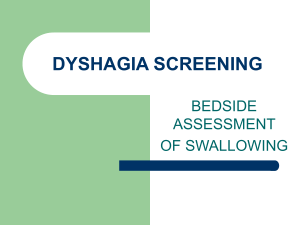
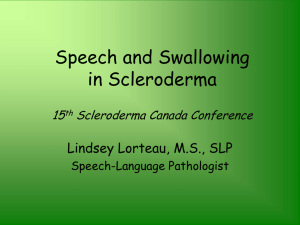

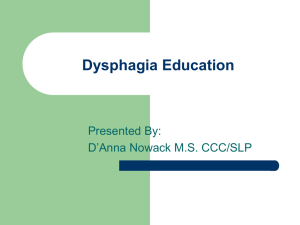
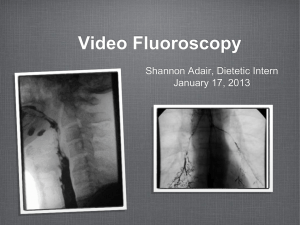
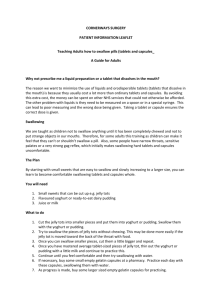

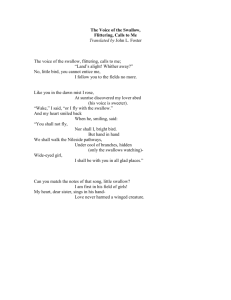
![Dysphagia Webinar, May, 2013[2]](http://s2.studylib.net/store/data/005382560_1-ff5244e89815170fde8b3f907df8b381-300x300.png)
